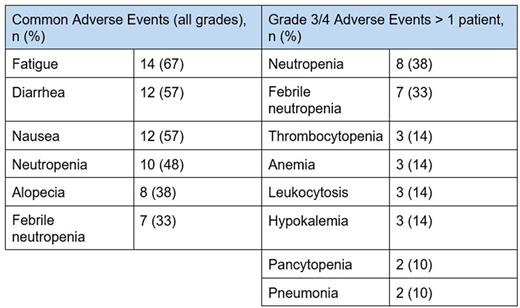Abstract
Introduction: Rituximab-CHOP (R-CHOP) remains the standard of care for patients with previously untreated DLBCL. Approximately 40% of patients are not cured with R-CHOP; thus, new therapies are needed. Obinutuzumab (GA101, G) is a glycoengineered type II anti-CD20 monoclonal antibody with improved direct cell death and antibody-dependent cell-mediated cytotoxicity compared to rituximab, and may have improved outcomes in certain patient subsets (Vitolo, ASH 2016). In addition, polatuzumab vedotin (pola) is an antibody drug conjugate (ADC) designed to deliver the potent microtubule inhibitor MMAE to cells expressing CD79b. Thus, pola has the potential to replace vincristine with a targeted agent (Tilly, ICML 2017). The dose escalation phase established a recommended phase 2 dose (RP2D) of pola at 1.8 mg/kg. We report updated results for this multicenter, open-label Phase Ib/II study of pola combined G-CHP at the RP2D (ClinicalTrials.gov NCT01992653).
Methods: In the dose escalation phase of this study, patients aged 18-80 years, with newly diagnosed or relapsed/refractory B-cell NHL with IPI 0-5 and ECOG 0-2 were given pola intravenously, 1.4 or 1.8 mg/kg, with G-CHP every 21 days for a total of 6 or 8 cycles. Standard doses of CHP and G (1000 mg on days 1, 8, and 15 in cycle 1, and 1000 mg on day 1 of each subsequent cycle) were used. In the dose expansion phase, pola was given at 1.8 mg/kg and patients were restricted to those with previously untreated DLBCL with IPI 2-5. Assessments for anti-tumor activity by Cheson 2007 were performed following 4 cycles of study treatment and at the end of study treatment (EOT).
Results: Enrollment in this arm has completed. As of March 31, 2017, 21 patients with previously untreated DLBCL (57% male) had been enrolled to receive G-CHP + pola at 1.8 mg/kg. The median age was 67 years (range 28-76). At baseline, patients had stage I/II (n=3), III/IV (n=18) disease and ECOG status of 0-1 (n=17). At screening, the IPI distribution was: IPI 0-1: 3 patients (14%); IPI 2: 10 patients (48%); IPI 3: 4 patients (19%); and IPI 4: 4 patients (19%). At the time of this report, all patients had completed treatment.
The adverse events (AE) across all grades that occurred in > 30% of patients and Grade 3/4 AEs that occurred in more than one patient are presented in Table 1.
Table 1: Common Adverse Events and Grade 3/4 Adverse Events
Table.jpg
Nine patients (43%) experienced 31 serious AEs including febrile neutropenia (29%), neutropenia (10%), pneumonia (10%), C. difficile (5%), sepsis (5%), septic shock (5%), coronary artery disease (5%), supraventricular tachycardia (5%), hyperglycemia (5%), vomiting (5%), asthenia (5%), syncope (5%), mental status change (5%), and acute kidney injury (5%). The septic shock was a grade 5 AE.
Eight patients (38%) experienced peripheral neuropathy; 6 (29%) with grade 1 and 2 (10%) with grade 2; no patients experienced peripheral neuropathy of grade 3 or above. 4 patients (19%) discontinued study treatment early due to AE for the following reasons: thrombocytopenia after Cycle 1, fatal septic shock after Cycle 4, coronary artery disease after Cycle 4, and febrile neutropenia after Cycle 5.
Efficacy by EOT PET-CT demonstrated overall response of 91% with 81% CR and 10% PR. The two patients without response were unevaluable, both discontinuing prior to response assessment due to AE (thrombocytopenia, septic shock). No responders had any evidence of relapse at time of this analysis with a median study duration of 10 months.
Conclusions: The novel combination of pola at 1.8 mg/kg plus G-CHP is active in previously untreated DLBCL and well tolerated.As expected, the main toxicities were related to neutropenia and peripheral neuropathy.
Forero-Torres: Roche: Research Funding; Genentech: Research Funding. Kolibaba: TG Therapeutics: Honoraria, Research Funding; Seattle Genetics: Research Funding; Pharmacyclics: Research Funding; Novartis: Research Funding; Janssen: Research Funding; Gilead Sciences, Inc: Consultancy, Research Funding; Genentech: Research Funding; Celgene: Research Funding; Cell Therapeutics: Research Funding; Acerta: Research Funding. Tilly: Gilead: Honoraria; Takeda: Consultancy, Honoraria; Celgene: Consultancy, Honoraria, Membership on an entity's Board of Directors or advisory committees, Research Funding; Karyopharm: Consultancy, Honoraria, Membership on an entity's Board of Directors or advisory committees; Roche: Consultancy, Honoraria, Membership on an entity's Board of Directors or advisory committees, Research Funding; Janssen: Consultancy, Honoraria, Membership on an entity's Board of Directors or advisory committees; Immunogen: Honoraria. Salles: Gilead: Consultancy, Other: Advisory board; Celgene: Consultancy, Other: Advisory board; Janssen: Consultancy, Other: Advisory board; Bristol-Myers Squibb: Consultancy, Other: Advisory board; Amgen: Consultancy, Other: Advisory board; Kite: Consultancy, Other: Advisory board; Merck: Consultancy, Other: Advisory board; Morphosys: Consultancy, Other: Advisory board; Novartis: Consultancy, Other: Advisory board; Roche: Consultancy, Other: Advisory board, Research Funding; Servier: Consultancy, Other: Advisory board. Wang: Genentech, Inc.: Consultancy, Employment. Lee: Genentech, Inc.: Employment. Sharman: Acerta: Consultancy, Research Funding; Seattle Genetics: Consultancy, Research Funding; Genentech: Consultancy, Honoraria, Other: GIBB is sponsored by Genentech Inc. Third-party editorial support, under the direction of Anthony Masaquel, was provided by Lynda McEvoy of Gardiner-Caldwell Communications, and was funded by F. Hoffmann-La Roche Ltd, Research Funding; TG Therapeutics: Consultancy, Research Funding; Gilead: Consultancy, Research Funding; Celgene: Consultancy, Honoraria, Research Funding.
Author notes
Asterisk with author names denotes non-ASH members.


This feature is available to Subscribers Only
Sign In or Create an Account Close Modal